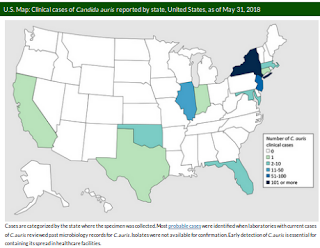#13,379
Two years ago this month (June 2016) the CDC issued a Clinical Alert to U.S. Health care facilities about the Global Emergence of Invasive Infections Caused by the Multidrug-Resistant Yeast Candida auris.
C. auris is an emerging fungal pathogen that was first isolated in Japan in 2009. It was initially found in the discharge from a patient's external ear (hence the name `auris'). Retrospective analysis has traced this fungal infection back over 20 years.Since then the CDC and public health entities have been monitoring an increasing number of cases (and hospital clusters) in the United States and abroad, generally involving bloodstream infections, wound infections or otitis.
Adding to the concern:
- C. auris infections have a high fatality rate
- The strain appears to be resistant to multiple classes of anti-fungals
- This strain is unusually persistent on fomites in healthcare environments.
- And it can be difficult for labs to differentiate it from other Candida strains
Additionally, based on targeted screening in four states reporting clinical cases, the CDC reports an additional 569 patients have been discovered to be asymptomatically colonized with C. auris.
Also an increase of 10% over the previous month.While the numbers remain relatively small, they are undoubtedly under reported, both here in the United States, and around the world. From the latest CDC update:
- Single cases of C. auris have been reported from Austria, Belgium, China, Malaysia, Norway, Russia, Switzerland, and the United Arab Emirates.
- Multiple cases of C. auris have been reported from Canada, Colombia, France, Germany, India, Israel, Japan, Kenya, Kuwait, Oman, Pakistan, Panama, Saudi Arabia, South Africa, South Korea, Spain, the United Kingdom, the United States (primarily from the New York City Area, New Jersey, and the Chicago area) and Venezuela; in some of these countries, extensive transmission of C. auris has been documented in more than one hospital.
- U.S. cases of C. auris have been found in patients who had recent stays in healthcare facilities in India, Kuwait, Pakistan, South Africa, the United Arab Emirates, and Venezuela, which also have documented transmission.
- Other countries not highlighted on this map may also have undetected or unreported C. auris cases.
Notes from the Field: Surveillance for Candida auris — Colombia, September 2016–May 2017)For more on this emerging fungal pathogen, you may wish peruse the CDC's dedicated web page:
ECDC: C. Auris Rapid Risk Assessment For Healthcare Settings - Europe
mSphere: Comparative Pathogenicity of UK Isolates of the Emerging Candida auris
- General Information about Candida auris
- Tracking Candida auris
- Patients and Family Members
- Healthcare Professionals
- Fact Sheet
- Publications


